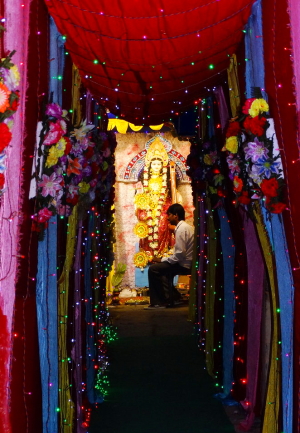
This year, it is considered auspicious for Hindus to wear both yellow and red on February 14, acknowledging the convergence of Vasant Panchami and Valentine’s Day. Traditionally, Vasant Panchami begins the spring cycle that ends with Holi. Photo courtesy of PxHere
WEDNESDAY, FEBRUARY 14: Welcome the approaching season of spring and don the color yellow, as Hindus and Sikhs in India and beyond celebrate the festival of Vasant Panchami (spellings vary).
2024: Wearing both yellow and red this Vasant Panchami—in recognition of this year’s convergence of the holiday and Valentine’s Day—is recommended, according to PTC News: “Yellow is the traditional color of Basant Panchami, symbolising the vibrancy of spring, while red is associated with love and passion on Valentine’s Day. Wearing Blend of Yellow and Red on February 14 is considered auspicious.”
Literally the fifth day of spring, Vasant Panchami honors Saraswati, the Hindu goddess of music, art, culture, learning and knowledge. Today begins the spring cycle that will end with Holi, the massive spring festival that is now celebrated internationally.
For Sikhs, Vasant Panchami marks the day in Amritsar when musicians begin singing the Basant Raga, a practice that will continue until the first day of Vaisakh. In some regions of India, kites fill the sky, and the festival is better known as the Basant Festival of Kites.
VASANT PANCHAMI: HONORING SARASWATI, KNOWLEDGE AND SPRING
An ancient celebration stretching back thousands of years, Vasant Panchami reveres Kamadeva, the god of love, and his friend Vasant (the personification of spring). In modern times, however, rituals for the goddess Saraswati have taken precedence over Kamadeva. Hindus treat Vasant Panchami as Saraswati’s birthday, worshiping the goddess and filling her temples with food. Figures of Saraswati are often draped in yellow clothing, and as the deity is considered supreme in many types of knowledge, students ask for her blessings. It is traditional that children begin learning the alphabet or their first words on Vasant Panchami, believing it auspicious to do so. While donning yellow clothing, Hindus often make and distribute yellow foods and treats to neighbors, family and friends.
Did you know? Saraswati is often depicted seated on a white lotus, with four hands. The four hands symbolize the aspects of learning: manas (mind, sense), buddhi (intellect, reasoning), citta (imagination, creativity) and ahamkāra (self consciousness, ego).
A log with a figure of the demoness Holika is placed in a public area on Vasant Panchami, and for 40 days, devotees will add twigs and sticks to form an enormous pile. The pyre is lit on Holi.
